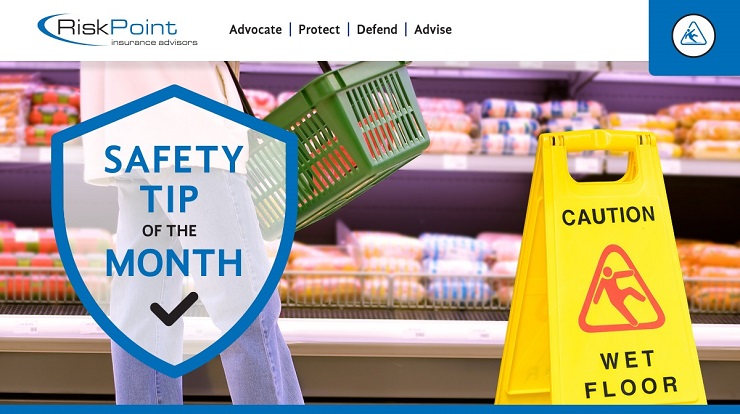Slip, trip and fall incidents are a common cause of injury, and grocery stores have many hazards that can contribute to these accidents. Both customers and employees are at risk.
Slip, trip and fall injuries are also a common reason for expensive personal injury lawsuits and a massive source of fraudulent claims. Don’t let your store be an easy target.
According to the National Insurance Crime Bureau, slip, trip and fall fraud can cost retail establishments $40,000 per incident or more! Last year in New York, three slip and fall fraudsters were found guilty of defrauding more than $31.7 million from local businesses and their insurers according to Justice.gov!
When you are proactive about slip, trip and fall prevention, accidents are much less likely to occur. Fraudsters are also less likely to stage an incident at your establishment. Regularly educate your team using the information and best practices below. One training is not enough – remind them of your expectations in every staff meeting.
Slips vs. Trips
Slips occur when there is a lack of traction between a person’s shoe and the floor. This lack of traction may be caused by wet or oily surfaces. In grocery stores, hazardous slip conditions may occur when the floor is wet due to weather or when something has been spilled on the floor.
Trips occur when a person’s foot collides with an object and the person loses balance. In grocery stores, hazardous trip conditions may occur when cords, hoses or other items are placed in walkways. Loose or broken flooring may also contribute to tripping hazards.
Indoor Safety
Hazards may be lurking among your aisles. Good policies and procedures can control the dangers while reducing your store’s liability.
- Keep walkways clear of cords and other tripping hazards.
- Provide entry mats to help keep areas dry during bad weather.
- Have employees check for spills and other hazards regularly.
- Use “wet floor” signs when the floor is slippery from rain or spills.
- Repair any cracks, breaks or tears in flooring or steps.
- Maintain documentation of maintenance work and regular inspections.
Outdoor Safety
Falls can also occur in parking areas and outer walkways. Don’t forget about these hazards.
Provide ample lighting in parking lots and other outer areas.
Have damaged surfaces or wheel stops repaired.
Keep walkways free of snow and ice.
Use bright paint to draw attention to steps and other tripping hazards.
If you are not responsible for outer areas, report problems to the entity that is responsible. Document your request for repairs.
Incident Response
If someone falls, the right response is essential to mitigating the damage.
If someone is injured, help the person and make sure proper medical care is provided.
Avoid admitting fault.
Document the incident. File a report, get witness testimony, take photographs and secure footage from security cameras.
Grocery stores face many unique risks. That’s why you need a partner who understands your business. Contact RiskPoint’s grocery team:
| Joe Scarpello | Melissa Johnson |
| 253.444.5584 | 253.444.5654 |
Want to share this information with your team? Download this safety tip here.


